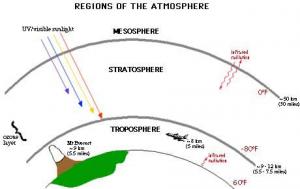Earth's Lower Atmosphere Is Warming, Review of Four Decades of Scientific Literature Concludes
Updatetime:2010-11-17From:
【Enlarge】【Reduce】
The troposphere, the lower part of the atmosphere closest to the Earth, is warming and this warming is broadly consistent with both theoretical expectations and climate models, according to a new scientific study that reviews the history of understanding of temperature changes and their causes in this key atmospheric layer.
Scientists at NOAA, the NOAA-funded Cooperative Institute for Climate and Satellites (CICS), the United Kingdom Met Office, and the University of Reading in the United Kingdom contributed to the paper, "Tropospheric Temperature Trends: History of an Ongoing Controversy," a review of four decades of data and scientific papers to be published by Wiley Interdisciplinary Reviews: Climate Change, a peer-reviewed journal.
The paper documents how, since the development of the very first climate models in the early 1960s, the troposphere has been projected to warm along with the Earth's surface because of the increasing amounts of greenhouse gases in the atmosphere. This expectation has not significantly changed even with major advances in climate models and is in accord with our basic physical understanding of atmospheric processes.
In the 1990s, observations did not show the troposphere, particularly in the tropics, to be warming, even though surface temperatures were rapidly warming. This lack of tropospheric warming was used by some to question both the reality of the surface warming trend and the reliability of climate models as tools. This new paper extensively reviews the relevant scientific analyses -- 195 cited papers, model results and atmospheric data sets -- and finds that there is no longer evidence for a fundamental discrepancy and that the troposphere is warming.
"Looking at observed changes in tropospheric temperature and climate model expectations over time, the current evidence indicates that no fundamental discrepancy exists, after accounting for uncertainties in both the models and observations," said Peter Thorne, a senior scientist with CICS in Asheville, N.C., and a senior researcher at North Carolina State University. CICS is a consortium jointly led by the University of Maryland and North Carolina State University.
This paper demonstrates the value of having various types of measurements -- from surface stations to weather balloons to satellites -- as well as multiple independent analyses of data from these observation systems.
"There is an old saying that a person with one watch always knows what time it is, but with two watches one is never sure," said Thomas Peterson, lead scientist at NOAA's National Climatic Data Center. "The controversy started with the production of the first upper-air temperature 'watch' in 1990, and it was only later when multiple additional 'watches' were made by different 'manufacturers' that we learned that they were each a few minutes off. Although researchers all agree the temperature is increasing, they disagree how much."
And while this is the first comprehensive review of the scientific literature on this topic, it is not the last word on the tropospheric temperature trend.
"Looking to the future, it is only through robust and varied observations and data analyses that we can hope to adequately understand the tropospheric temperature trend," said Dian Seidel, a NOAA scientist at the Air Resources Laboratory, in Silver Spring, Md.
The study was funded by UK Department of Energy and Climate Change, the UK Department of Environment, Food and Rural Affairs and NOAA.

Regions of the atmosphere. (Credit: NOAA)
Source:ScienceDaily
Nov. 16, 2010
Appendix




